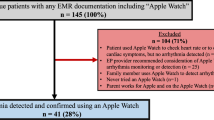Abstract
Long-term ECG is widely used in diagnosis and assessment of many cardiac symptoms which may be caused by dangerous arrhythmias that sometimes can be difficult to document. The PocketECG system is a new technological solution for a long-term, noninvasive, continuous and real-time ECG monitoring that provides automatic diagnosis of dysrhythmias. ECG data transmission occurs over a mobile network. The goal of this study was to assess the reliability of long-term ECG recordings acquired with the PocketECG system. One hundred and fifteen patients (43 girls and 72 boys) of an average age of 15.5 ± 2.5 years were examined at the Department of Cardiology at the Children’s Memorial Health Institute. Two simultaneous 24-h ECG recordings were conducted: one with a Holter monitor and one with the PocketECG system. A linear correlation was demonstrated between the two methods with regard to the recorded QRS complexes [H = 1173.0 (−1946.40; 4838.50) + PocketECG*0.98 (0.94; 1.02)]. Mean diurnal heart rhythms were comparable (p > 0.05) despite the fact that the slowest and the fastest rates were different. The rate of detection for ventricular, supraventricular dysrhythmias and pauses in ventricular rhythm were comparable in both methods. The PocketECG system for continuous and real-time ECG recording is a reliable method for the assessment of heart rhythm and dysrhythmias in children and adolescents.






Similar content being viewed by others
Explore related subjects
Discover the latest articles and news from researchers in related subjects, suggested using machine learning.References
Southall DP, Johston F, Shinebourne EA, Johnston PGB (1981) 24-hour electrocardiographic study of heart rate and rhythm patterns in population of healthy children. Br Heart J 45:281–291
Emmel M, Sreeram N, Schickendantz S, Brockmeier K (2006) Experience with an ambulatory 12-lead Holter recording system for evaluation of pediatric dysrhythmias. J Electrocardiol 39:188–193
Hegazy RA, Lotfy WN (2007) The value of Holter monitoring in the assessment of pediatric patients. Indian Pacing Electrophysiol J 7:204–214
Karpawich PP, Cavitt DL, Sugalski JS (1993) Ambulatory arrhythmia in symptomatic children and young adults: comparative effectiveness of Holter and telephone event recordings. Pediatr Cardiol 14:147–150
Balmelli N, Naegeli B, Bertel O (2003) Diagnostic yield of automatic and patient-triggered ambulatory cardiac event recording in the evaluation of patients with palpitations, dizziness, or syncope. Clin Cardiol 26:173–176
Park MH, de Asmundis C, Chierchia GB, Sarkozy A, Benatar A, Brugada P (2011) First experience of monitoring with cardiac event recorder electrocardiography Omron system in childhood population for sporadic, potentially arrhythmia-related symptoms. Europace 13:1335–1339
Babuty D, Pierre B, Grimard C, Zannad N, Marie O, Fauchier L (2009) Implantable loop recorder for recurrent syncopes. Minerva Med 100:293–305
Sanatani S, Perione A, Chiu Ch, Human DG, Gross GJ, Hamilton R (2002) Use of an implantable loop recorder in the evaluation of children with congenital heart disease. Am Heart J 143:366–372
Rossano J, Bloemers B, Sreeram N, Balaji S, Shah MJ (2003) Efficacy of implantable loop recorders in establishing symptom-rhythm correlation in young patients with syncope and palpitations. Pediatrics 112:228–233
Gass M, Apitz C, Salehi-Gilani S, Ziemer G, Hofbeck M (2006) Use of the implantable recorder in children and adolescents. Cardiol Young 16:572–578
Sreeram N, Gass M, Apitz C, Ziemer G, Hofbeck M, Emmel M, Brockmeier K, Hitchcoc F, Bennik G (2008) The diagnostic yield from implantable loop recorders in children and young adults. Clin Res Cardiol 97:327–333
Kothari DS, Riddell F, Smith W, Voss J, Skinner JR (2006) Digital implantable loop recorders in the investigation of syncope in children: benefits and limitations. Heart Rhythm 3:1306–1312
Frangini PA, Cecchin F, Jordao L, Matuscello M, Alexander ME, Triedman JK, Walsh EP, Berul ChI (2008) How revealing are insertable loop recorders in pediatrics? PACE 31:338–343
Al Dhahri KN, Potts JE, Chiu CC, Hamilton RM, Sanatani S (2009) Are implantable loop recorders useful in detecting arrhythmias in children with unexplained syncope? Pacing Clin Electrophysiol 32:1422–1427
Dziubiński M (2011) PocketECG: a new continuous and real-time ambulatory arrhythmia diagnostic method. Cardiol J 18:454–460
Olson JA, Fouts AM, Padanilam BJ, Prystowsky EN (2007) Utility of mobile cardiac outpatient telemetry for the diagnosis of palpitations, presyncope, syncope, and the assessment of therapy efficacy. J Cardiovisc Electrophisiol 18:473–477
Leshem-Rubinow E, Berger M, Shacham J, Birati EY, Malov N, Tamari M, Golovner M, Roth A (2011) New real-time loop recorder diagnosis of symptomatic arrhythmia via telemedicine. Clin Cardiol 34:420–425. doi:10.1002/clc.20906
Author information
Authors and Affiliations
Corresponding author
Ethics declarations
Conflict of interest
The authors have no conflicts of interest to declare.
Rights and permissions
About this article
Cite this article
Bieganowska, K., Kaszuba, A., Bieganowski, M. et al. PocketECG: A New Noninvasive Method for Continuous and Real-Time ECG Monitoring—Initial Results in Children and Adolescents. Pediatr Cardiol 38, 448–455 (2017). https://doi.org/10.1007/s00246-016-1534-0
Received:
Accepted:
Published:
Issue Date:
DOI: https://doi.org/10.1007/s00246-016-1534-0




